
Platanus × acerifolia, Platanus × hispanica, or hybrid plane, is a tree in the genus Platanus. It is often known by the synonym London plane or London planetree. It is a hybrid of Platanus orientalis and Platanus occidentalis.

Platanus occidentalis, also known as American sycamore, American planetree, western plane, occidental plane, buttonwood, and water beech, is a species of Platanus native to the eastern and central United States, the mountains of northeastern Mexico, extreme southern Ontario, and extreme southern Quebec. It is usually called sycamore in North America, a name which can refer to other types of trees in other parts of the world. The American sycamore is a long-lived species, typically surviving at least 200 years and likely as long as 500–600 years.
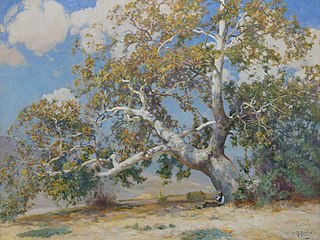
Platanus racemosa is a species of plane tree known by several common names, including California sycamore, western sycamore, California plane tree, and in North American Spanish aliso. Platanus racemosa is native to California and Baja California, where it grows in riparian areas, canyons, floodplains, at springs and seeps, and along streams and rivers in several types of habitats. It can be found as far north as Tehama and Humboldt counties.

Acer pseudoplatanus, known as the sycamore in the British Isles and as the sycamore maple in the United States, is a species of maple native to Central Europe and Western Asia. It is a large deciduous, broad-leaved tree, tolerant of wind and coastal exposure.
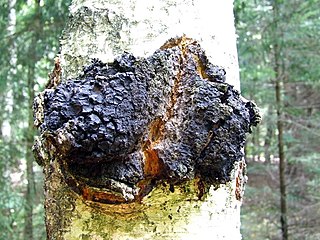
Inonotus obliquus, commonly called chaga, is a fungus in the family Hymenochaetaceae. It is parasitic on birch and other trees. The sterile conk is irregularly formed and resembles burnt charcoal. It is not the fruiting body of the fungus, but a sclerotium or mass of mycelium, mostly black because of a great amount of melanin. Some people consider chaga medicinal.
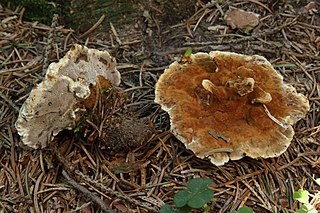
Onnia tomentosa is a species of fungus in the family Hymenochaetaceae commonly known as the woolly velvet polypore. It is frequently found in coniferous forests at higher altitudes, often growing in large groups, rather rare at lower altitudes. It is a plant pathogen, and causes tomentosus root rot, primarily in spruce. It was formerly known as Inonotus tomentosum (Fr.) Teng until molecular phylogenetic analysis led to major revisions in the classification of the Hymenochaetaceae.
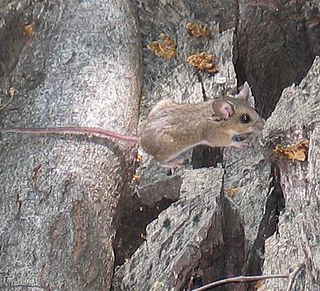
The brush mouse is a species of rodent in the family Cricetidae. It is found in mountainous areas of Mexico and the western United States at altitudes over 2,000 m (6,600 ft).

Cortinarius caperatus is an edible mushroom of the genus Cortinarius found in northern regions of Europe and North America. It was known as Rozites caperata for many years before genetic studies revealed that it belonged to the genus Cortinarius. The fruit bodies appear in autumn in coniferous and beech woods as well as heathlands in late summer and autumn. The ochre-coloured cap is up to 10 cm (4 in) across and has a fibrous surface. The clay-colored gills are attached to the stipe under the cap, and the stipe is whitish with a whitish ring. The Latin specific name, caperatus, means wrinkled, and refers to the distinctive texture of the cap. The flesh has a mild smell and flavor.

Inonotus is a genus of fungi in the family Hymenochaetaceae. The genus, described by Petter Karsten in 1879, is estimated to contain about 80 species sensu lato and 30 species sensu stricto.

A plant community is a collection or association of plant species within a designated geographical unit, which forms a relatively uniform patch, distinguishable from neighboring patches of different vegetation types. The components of each plant community are influenced by soil type, topography, climate and human disturbance. In many cases there are several soil types present within a given plant community. This is because the soil type within an area is influenced by two factors, the rate at which water infiltrates or exits the soil, as well as the rate at which organic matter enters or decays from the soil. Plant communities are studied substantially by ecologists, due to providing information on the effects of dispersal, tolerance to environmental conditions, and response to disturbance of a variety of plant species, information valuable to the comprehension of various plant community dynamics.

Polyozellus is a fungal genus in the family Thelephoraceae, a grouping of mushrooms known collectively as the leathery earthfans. Previously considered a monotypic genus, it now contains the Polyozellus multiplex species complex. The genus name is derived from the Greek poly meaning many, and oz, meaning branch. It is commonly known as the blue chanterelle, the clustered blue chanterelle, or, in Alaska, the black chanterelle. The distinctive fruit body of this species comprises blue- to purple-colored clusters of vase- or spoon-shaped caps with veiny wrinkles on the undersurface that run down the length of the stem.

Corythucha ciliata, the sycamore lace bug, is a species of lace bug in the family Tingidae that is associated with sycamore trees.

Platanus wrightii, the Arizona sycamore, is a sycamore tree native to Arizona and New Mexico with its range extending south into the Mexican states of Sonora, Chihuahua, and Sinaloa.

Hapalopilus rutilans is a species of polypore fungus in the family Polyporaceae. Officially described in 1821, it was transferred to its current genus Hapalopilus six decades later. It is commonly known as the tender nesting polypore, purple dye polypore, or the cinnamon bracket. This widely distributed species is found on five continents. It grows on the fallen or standing dead wood of deciduous trees, in which it fruits singly, in groups, fused, or in overlapping clusters. Fruit bodies are in the form of kidney-shaped to semicircular, cinnamon-orange-brown brackets. The underside of the fruit body features a yellowish to brownish pore surface with tiny angular pores, from which spores are released.

Xerocomellus is a genus of fungi in the family Boletaceae. The genus, as it was described in 2008, contained 12 species. However X. rubellus and X. engelii were transferred to the new genus Hortiboletus and X. armeniacus was transferred to the new genus Rheubarbariboletus in 2015. Molecular analysis supports the distinction of Xerocomellus species from Boletus and Xerocomus, within which these species were formerly contained. Xerocomellus in fact is only distantly related to Xerocomus and is most closely related to Tylopilus, Boletus sensu stricto, Porphyrellus, Strobilomyces, and Xanthoconium.

Robert Lee Gilbertson was a distinguished American mycologist and educator. He was a faculty member at University of Arizona for 26 years until his retirement from teaching in 1995; he was a Professor Emeritus at U of A until his death on October 26, 2011, in Tucson, Arizona. 2011. He held concurrent positions as Plant Pathologist, Agricultural Experiment Station, University of Arizona (1967–95) for a project Research on wood-rotting fungi and other fungi associated with southwestern plants and was collaborator and consultant with Center for Forest Mycology Research, US Forest Service, Forest Products Laboratory, Madison, Wisconsin (1957–1981).
Tropicoporus tropicalis is a mushroom of the family Hymenochaetaceae. Tropicoporus tropicalis is a wood-decaying basidiomycetes that rarely causes disease in animals and human, and is commonly found in humid climate such as Brazil. In its natural environment, the fungus is associated with white rot woody angiosperms, and has its annual fruiting body on tree trunks and branches. Tropicoporus tropicalis has two kinds of hyphae, generative and skeletal, that lack clamp connections.
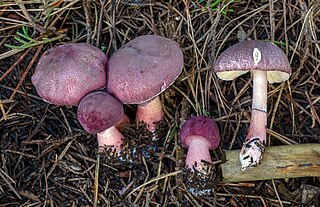
Lepiota decorata, also known as the pink parasol, is an uncommon species of gilled mushroom found in North America. The cap of L. decorata usually has a speckled violet pattern, stains orange when scratched, and is about 4 to 8 cm in diameter.

Phellinus arctostaphyli, also known as the manzanita conk or the manzanita hoof polypore, is a species of shelf fungus. Native to western North America, this saprotrophic fungus only colonizes the wood of Ceanothus, Adenostoma, and Arctostaphylos.P. arctostaphyli is closely to related to three other North American Phellinus species, including Phellinus tremulae and Phellinus tuberculosus. However, in part due to the "economic insignificance of its hosts," P. arctostaphyli is relatively poorly studied as an individual species.

Entoloma ferruginans is an endemic mushroom of California in North America. It smells distinctly like a chlorinated pool at the YMCA, thus the common name bleachy entoloma. E. ferruginans lives in mycorrhizal association with live oaks south of the San Francisco Bay. This mushroom was first described by Charles Horton Peck in 1895 from a type specimen collected under oak trees in Pasadena.



















